Introduction
In today’s fast-paced world, many of us find ourselves tethered to desks for hours on end, navigating the perils of a sedentary lifestyle. Prolonged sitting not only drains our energy but also takes a toll on our leg health, leading to discomfort and long-term issues like poor circulation and varicose veins. Enter compression socks—a deceptively simple yet powerful solution designed to counteract the adverse effects of extended periods of inactivity. These specialized garments harness the principles of graduated compression to enhance blood flow, reduce swelling, and alleviate fatigue, making them an essential accessory for anyone confined to a chair for the majority of the day. Whether you’re an office worker, a remote employee, or someone managing a medical condition, understanding the benefits of compression socks can transform your daily routine and promote overall well-being. Dive into expert insights that unveil why integrating compression socks into your everyday life is not just a trend, but a proactive step towards healthier legs and a more comfortable sitting experience.
When you sit all day, gravity makes your circulation sluggish, causing blood and fluid to pool in your lower legs. This leads to swelling, achiness, and fatigue. Compression socks apply gentle pressure, acting as a support system to help your veins push blood back toward your heart, preventing discomfort and lowering the risk of blood clots.
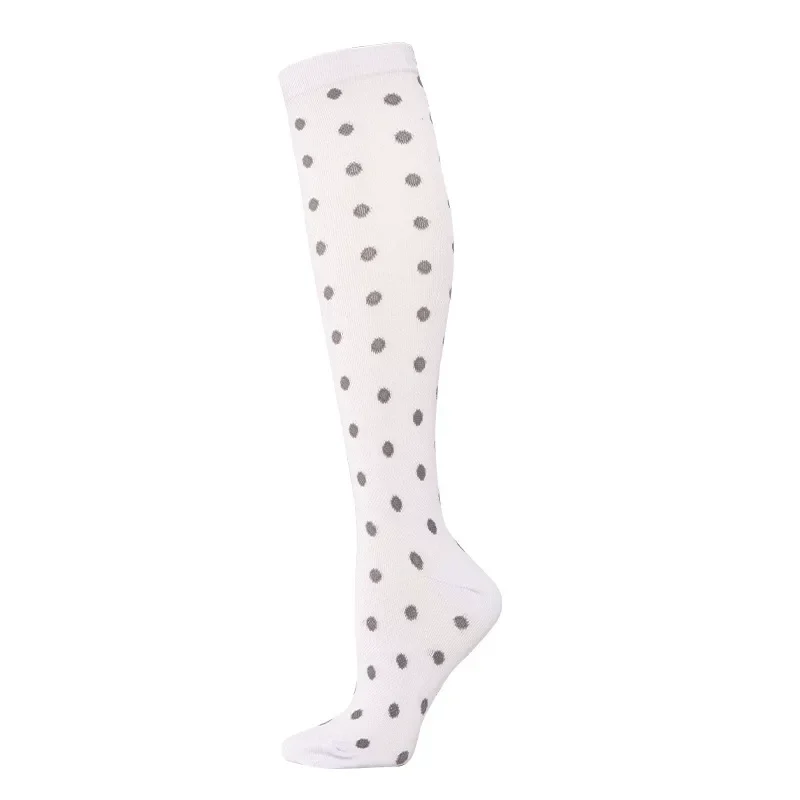
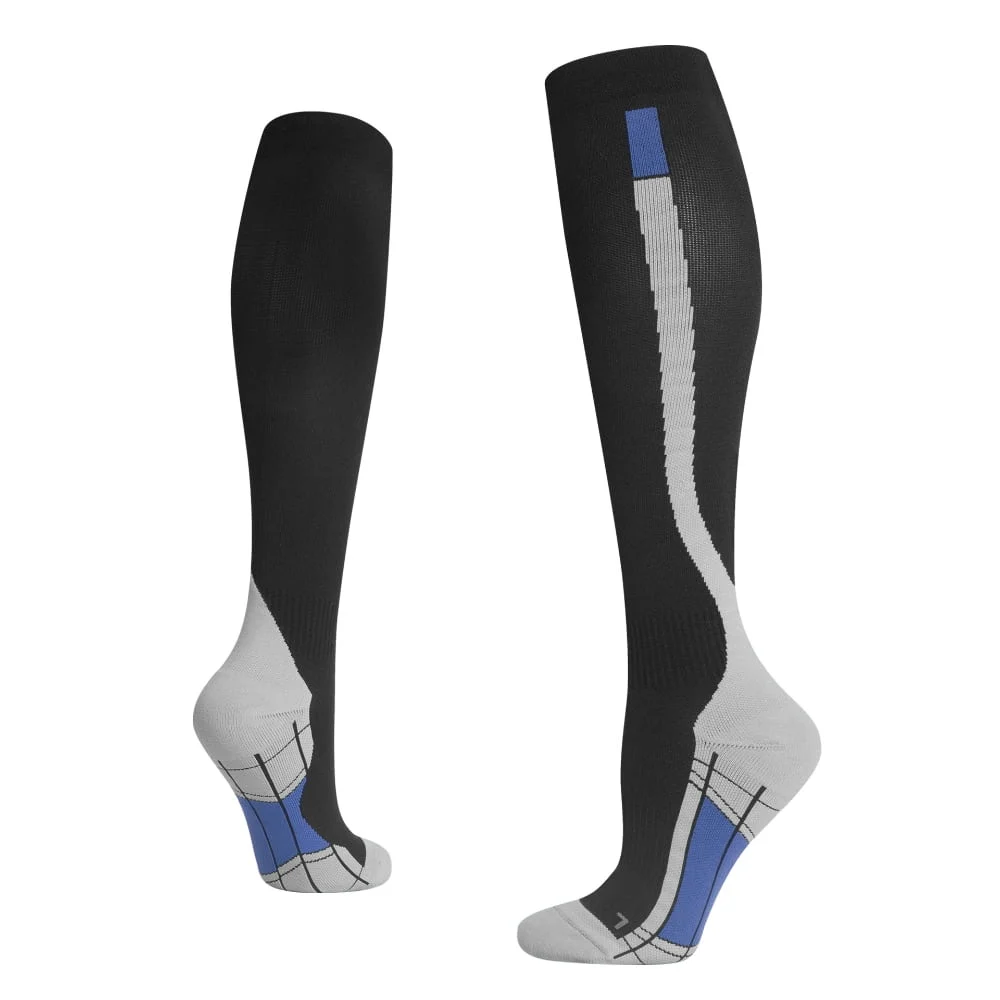
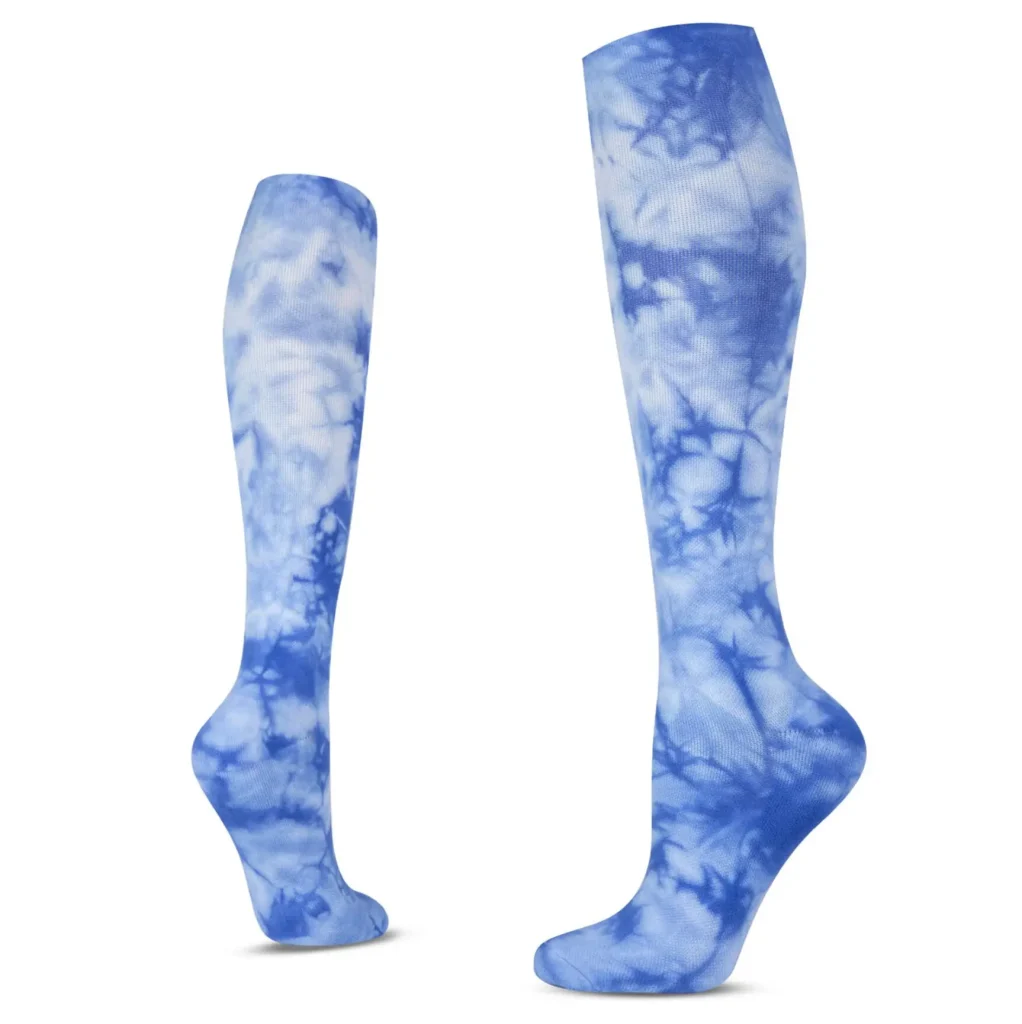
Understanding Compression Technology
Compression socks are scientifically designed to enhance leg health, particularly during periods of inactivity. Their design is based on medical and physiological principles that provide real benefits for those who spend long hours sitting. The key to their effectiveness lies in how they promote circulation and counteract the negative effects of prolonged sitting.
How Compression Socks Work: The Science Explained
At the core of compression socks is the principle of graduated compression. Unlike regular socks, which apply uniform pressure, these socks feature the highest pressure at the ankle, which gradually decreases as it moves up the leg. For a more in-depth comparison, check out our article on the Difference between Regular Socks and Compression Socks. This targeted pressure helps guide blood flow upward, preventing it from pooling in the feet and ankles, and improving circulation back toward the heart. By encouraging better blood flow, these socks prevent discomfort and reduce the risk of circulatory issues.

Graduated Compression: How It Targets Different Areas of the Leg
Graduated compression works by applying varying levels of pressure to different parts of the leg. The most pressure is concentrated at the ankle, where blood flow tends to slow, and the pressure decreases as the sock moves up the leg. This helps push blood upward, relieving swelling and reducing the feeling of heavy legs. By promoting healthy circulation, compression socks support venous health and help prevent more serious circulatory problems over time.
The Hidden Dangers of Sitting All Day
Sitting for extended periods, whether at a desk or on the couch, can have profound effects on health. The body isn’t designed for prolonged inactivity, and the risks of sitting too long are more serious than most realize. Here’s a deeper look at the dangers associated with a sedentary lifestyle:
- Poor Circulation: Sitting restricts blood flow, causing blood to pool in the legs and feet. This can lead to swelling, discomfort, and a higher risk of varicose veins and deep vein thrombosis (DVT).
- Cardiovascular Health Issues: Prolonged sitting can predispose the cardiovascular system to complications such as high cholesterol, elevated blood pressure, and poor circulation. Studies show that reducing sedentary time and increasing movement can significantly improve heart health. For example, a study of office workers found that those who made a conscious effort to stand up and move around saw a decrease in systolic blood pressure, weight loss, and a reduction in waist circumference—all contributing to better cardiovascular health.
- Increased Risk of Disease: A sedentary lifestyle is associated with an increased risk of several preventable diseases, including obesity, type 2 diabetes, and cardiovascular conditions. Research from the World Cancer Research Fund links physical inactivity with a higher risk of stroke, diabetes, obesity, and even certain types of cancer. Regular physical activity has been shown to significantly reduce these risks.
- Muscle Stiffness & Posture Problems: Prolonged sitting can cause muscle stiffness and tension, particularly in the shoulders, neck, and lower back. This leads to poor posture and discomfort, especially when sitting for long hours while typing or looking at screens. Inactive muscles, especially in the hips and legs, weaken over time, while the surrounding muscles become overworked, increasing the risk of injury and chronic pain.
- Decreased Bone Density: Without weight-bearing activity like walking or standing, bones become weaker, reducing bone density and increasing the risk of osteoporosis. This is particularly concerning as individuals age, as the lack of movement accelerates the process of bone degeneration, leading to an increased risk of fractures.
- Cognitive Decline: Sedentary behavior also affects brain health. Studies have shown that prolonged inactivity can lead to a reduction in the thickness of the medial temporal lobe, which plays a critical role in memory. Over time, this can contribute to cognitive decline and increase the risk of neurological conditions, such as Alzheimer’s disease and other forms of dementia.
Health Benefits of Compression Socks
Compression socks provide far-reaching benefits, especially for individuals who spend long hours seated. These garments do more than just offer comfort—they support circulation, alleviate leg discomfort, and improve overall health. Whether working at a desk, traveling, or recovering from a physically demanding day, compression socks can be a simple yet effective solution to counteract the negative effects of prolonged inactivity.
Improve Blood Circulation and Reduce Swelling
Compression socks apply gentle, graduated pressure that helps encourage better blood flow, especially in the lower legs. By preventing blood from pooling, they reduce swelling in the feet and ankles. This boosts overall circulation, promoting healthier veins and improved nutrient delivery to muscles, which contributes to better overall well-being.
Prevention of Related Diseases
Wearing compression socks regularly can lower the risk of serious vascular issues. By enhancing circulation, they help prevent varicose veins and reduce the risk of deep vein thrombosis (DVT), a dangerous condition caused by blood clots. With consistent use, these socks support vascular health and reduce the likelihood of complications associated with poor circulation.
Relieves Leg Discomfort
Compression socks provide immediate relief from discomfort such as heaviness and fatigue, which are common when sitting for long periods. The gentle pressure improves blood flow, alleviating the discomfort caused by stagnant circulation, and makes the legs feel lighter and more energized throughout the day.
Improves Performance and Recovery
While compression socks are widely used by athletes, their benefits extend to anyone looking to improve recovery after physical activity. These socks reduce muscle soreness and inflammation by promoting blood flow during and after exercise, speeding up recovery and reducing downtime between workouts.
Who Can Benefit Most from Compression Socks?
Compression socks provide significant benefits for a wide range of individuals, particularly those who experience long periods of sitting or standing. By improving circulation and offering consistent support, they help alleviate discomfort and reduce potential health risks. Here’s a breakdown of who can benefit most:

Professionals Who Stand for Long Periods of Time
People in occupations that require extended hours of standing, such as healthcare workers(doctors and nurses), teachers, retail staff, chefs, waiters, construction workers, flight attendants, and factory employees, often experience fatigue, swelling, and poor circulation. Compression socks provide targeted support, reducing discomfort, improving circulation, and helping workers maintain energy throughout their shifts.
People Who Sit for Long Periods of Time
Office workers, programmers, truck drivers, cab drivers, and others who spend significant time sitting can experience poor circulation and swelling. By wearing compression socks, individuals can enhance blood flow, reduce swelling, and alleviate discomfort. These socks help counteract the negative effects of inactivity, ensuring comfort during long hours of sitting.
Athletes
Athletes, both professional and amateur, wear compression socks to promote circulation during exercise, which aids in enhancing endurance and reducing muscle fatigue. After physical exertion, they assist in minimizing soreness and inflammation, supporting quicker recovery times, and allowing athletes to maintain peak performance for upcoming training sessions or competitions.
Special Populations
Compression socks are also helpful for certain groups with specific needs. Pregnant women often experience leg swelling, and compression socks help alleviate this by improving circulation. Wheelchair users, with limited mobility, find relief from poor circulation and swelling. Long-haul travelers, whether on flights or extended road trips, can reduce their chances of developing deep vein thrombosis (DVT) by wearing compression socks. Post-surgery patients also benefit, as they support faster recovery and reduce the likelihood of complications like blood clots.
Choosing the Right Compression Socks for You
When selecting compression socks, it’s important to consider your specific needs and lifestyle. Whether you’re managing a health condition or simply seeking comfort during long hours of sitting or standing, the right pair can make all the difference. Here’s how to choose the best socks for your individual situation.
Choose According to Your Health Condition and Compression Level
When selecting compression socks, it’s essential to match both your specific health condition and the appropriate compression level. The level of pressure these garments provide is measured in millimeters of mercury (mmHg), and the right amount of pressure depends on your individual needs.
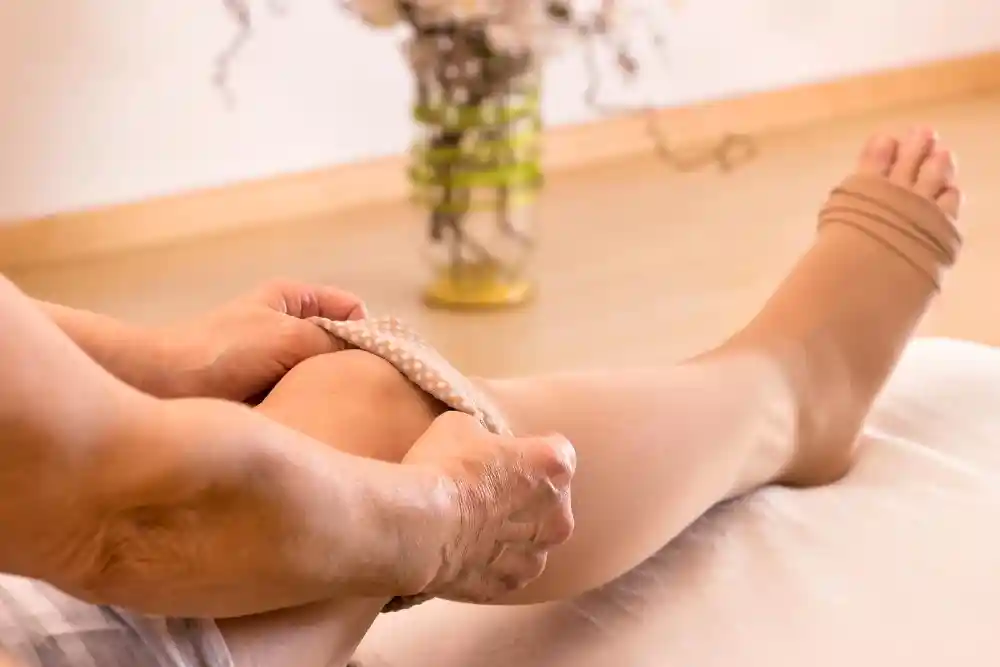
For Healthcare Conditions: If you’re managing a condition such as varicose veins, swelling, or have a history of blood clots (like deep vein thrombosis), higher levels of compression are often necessary. Medical-grade stockings typically provide 20-30 mmHg of pressure or more, which helps improve circulation and reduces swelling. For more severe conditions, compression levels can go up to 30-40 mmHg or higher, and these are typically recommended by healthcare providers to address specific vascular concerns. Always consult your doctor to determine the right level for your condition.
For Healthy Individuals with Sedentary Lifestyles: If you are generally healthy but spend long hours sitting or standing at work, a 15-20 mmHg compression level is usually enough. This moderate compression helps improve blood flow and reduce the sensation of heavy or tired legs without being too tight or restrictive. Ideal for office workers, teachers, or anyone with a job that requires prolonged sitting or standing, this level offers comfort and support throughout the day.
Types of Socks: Gradient Compression Socks, Anti-Embolism Socks
There are several types of compression socks available, each suited to different needs.
Gradient Compression Socks: These are the most common type, designed with varying levels of pressure. The socks apply the highest pressure at the ankle and gradually decrease up the leg. This type is ideal for improving circulation and preventing swelling, making it a great choice for people who stand or sit for long periods.
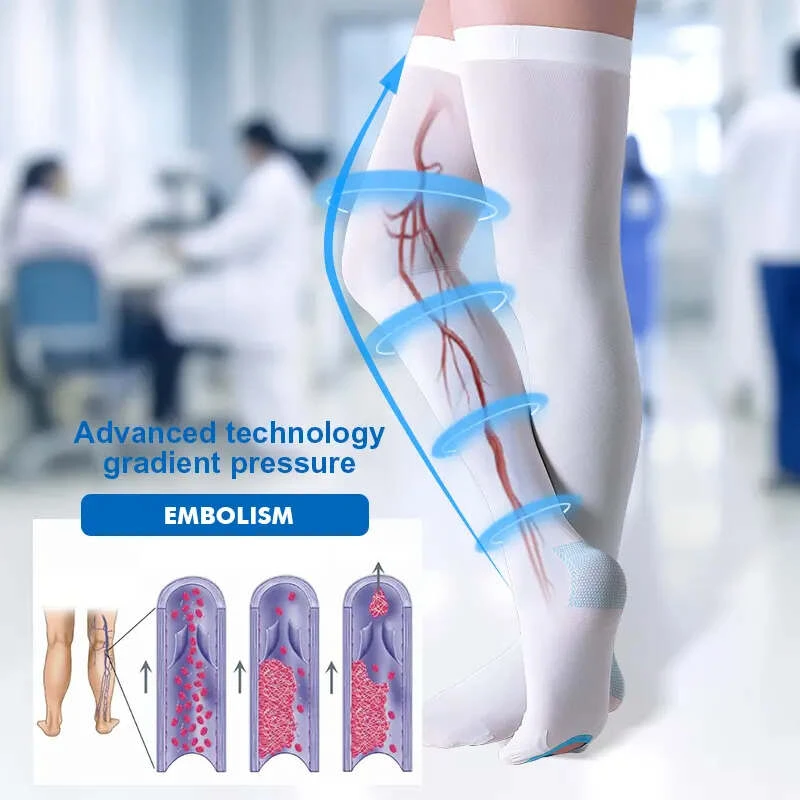
Anti-Embolism Socks: These are primarily used for medical purposes and are often recommended for individuals recovering from surgery or those at risk of developing blood clots. They are designed to promote better blood flow in the legs, preventing conditions like DVT. Anti-embolism stockings tend to have a higher level of compression and are best worn under the guidance of a doctor.
Selecting the Best Materials and Styles for Comfort
When choosing compression socks, material and style are crucial factors in ensuring comfort throughout the day. Look for socks made from breathable, moisture-wicking fabrics like cotton, nylon, or spandex, which help keep your legs dry and cool. For those working in warmer environments, lightweight materials are especially important.
The style of the socks is another key consideration. Some individuals prefer knee-high socks for more targeted pressure on the lower legs, while others may opt for thigh-high or full-leg options for more comprehensive support. There are also styles with added features such as reinforced heels and toes, which improve durability and comfort.
Expert Tips: Maximizing the Benefits
To get the most out of compression socks, it’s essential to ensure proper fit, consistent use, and integration with healthy habits that promote circulation. Here are some expert tips to help you maximize the effectiveness of your socks and support your overall leg health.
Correct Size and Fit: What to Look For
The fit of your compression socks plays a critical role in their effectiveness. If they are too tight, they may cause discomfort or restrict blood flow, while socks that are too loose won’t provide the support you need. To find the right size, take measurements of your ankle, calf, and leg length. This ensures a snug fit without being restrictive. Opt for socks with graduated pressure—tighter at the ankle and loosening up the leg. Always refer to sizing guides, and consult a healthcare professional if you’re unsure.
When and How to Wear Compression Socks Effectively
For maximum benefit, wear compression socks during times when circulation support is most needed. If you sit for extended periods, such as at a desk, wear them before starting your day to prevent swelling and discomfort. If you stand for long hours, put them on at the beginning of the day for consistent support. You can even wear them at night to aid recovery after intense physical activity.
When wearing them, make sure they are properly applied. Start by pulling the socks on from the toes, making sure there are no wrinkles or bunching. The socks should feel snug but comfortable, providing consistent pressure without cutting off circulation.
Integration with Other Sedentary Harm Reduction Methods
While compression socks are a powerful tool, they work best when combined with other strategies. Take regular breaks—stand, walk, or stretch every hour to boost circulation and prevent stiffness. Simple leg movements like ankle rotations or calf raises can also help keep blood flowing.
In addition, good posture is essential. Avoid slouching or crossing your legs for long periods. Consider using an ergonomic chair or a standing desk to improve posture and reduce pressure on your legs. Hydration is another key factor—adequate water intake helps reduce fluid retention and supports healthy circulation.
Conclusion: Incorporating Compression Socks into Your Daily Routine
Compression socks are a practical and effective solution for improving circulation, reducing swelling, and enhancing comfort, especially for individuals who spend long periods sitting or standing. By applying graduated pressure, these socks help boost blood flow, alleviate discomfort, and support long-term leg health. Whether for preventing varicose veins, reducing fatigue, or aiding recovery, their benefits are numerous. By incorporating compression socks into your daily routine, you can significantly improve leg health and comfort. Choosing the right fit and compression level tailored to your specific needs is essential for maximizing the benefits.
If you’re looking to offer your customers a practical solution for improved comfort and leg health, now is the perfect time to explore high-quality compression socks. With growing demand for wellness products, stocking custom-branded compression socks in bulk is an excellent way to cater to a wide range of needs—from office workers to healthcare professionals. By adding this versatile product to your offerings, you can elevate your brand’s value and meet the increasing market demand. Ready to get started? Contact us today to explore our custom bulk options and provide your customers with the comfort and support they deserve.
FAQ
1. How do compression socks actually help if I’m just sitting still?
When you sit, gravity causes blood and fluid to pool in your lower legs. Compression socks apply gentle, upward pressure, squeezing this stagnant fluid back into circulation. This prevents the swelling, achiness, and heavy-leg feeling common after a long day at a desk, while also reducing health risks.
2. What specific benefits will I notice from wearing them at my desk job?
You will primarily notice less swelling in your ankles and feet by the end of the day. Your legs will also feel more energized and less achy. In the long term, you are actively reducing your risk of developing circulation-related issues like varicose veins and blood clots (DVT).
3. Can wearing compression socks all day at the office be harmful?
They are very safe and beneficial when fitted correctly. Harm can only occur if they are the wrong size and fit too tightly, which can cause pain or restrict circulation. Always ensure you are wearing the proper size to get all the benefits without the risks of an incorrect fit.
4. Should I only wear them while I’m at my desk, or at other times too?
While they are perfect for the office, their benefits apply to any period of prolonged inactivity. This includes long flights, car rides, or extended bed rest. They are an excellent tool to support healthy circulation whenever your legs are still for a long time, not just during work hours.
5. Do I need to wear them 24/7, or should I take them off after work?
You should take them off after your period of inactivity. It is best to put them on in the morning and remove them before you go to bed. While wearing them for a short nap is fine, taking them off at night allows your skin to breathe and gives your legs a necessary break.
